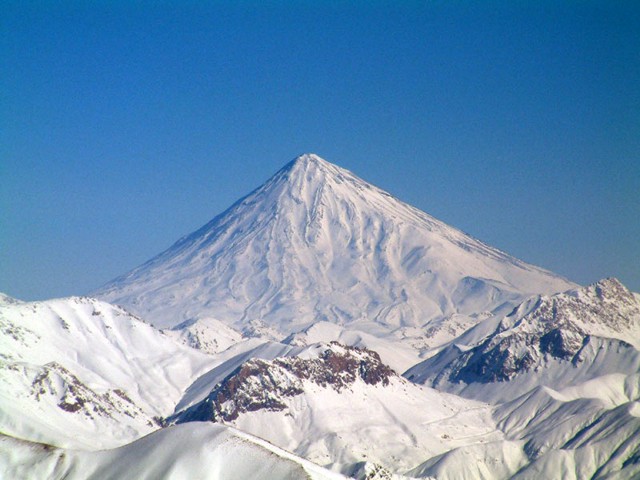Volcanic mountains form due to the eruption of molten material and the accumulation of such material. An explosion occurs when the pressure of gases and molten rocks in the Earth's core becomes excessively high. Outbreaks can occur slowly or explosively, accompanied by molten material flows, toxic gases, ash emissions, and volcanic fire. Iran has five volcanoes: Damavand, Sabalan, Taftan, Bazman, and Sahand. Out of these, Bazman, Taftan, and Damavand are considered active volcanoes.
Bazman
(stratovolcano 3490 m / 11,450 ft)Bijar Volcanic Field
(Pyroclastic cone(s) unknown)Damavand
(stratovolcano 5670 m / 18,602 ft)
Conical snow-capped Damavand volcano is the highest volcano in the Middle East. It towers dramatically 70 km to the NE above Iran's capital city of Tehran. Activity at the 5670-m-high stratovolcano has been dominated by lava effusion. Young lava flows erupted from the summit vent blanket the western side of the volcano, and the youngest dated lava flows were erupted about 7000 years ago. Photo by Arad Mojtahedi, 2006 (http://en.wikipedia.org/wiki/Image:Damavand_in_winter.jpg)
Damavand last erupted about 7,300 years ago... [more]
Dehaj-Meduk
(Volcanic field unknown)East Neh
(Unknown unknown)Gandom Beryan
(Unknown 500 m / 1640 ft)Kuh-e Ayyub Ansar
(Lava dome 2506 m / 8222 ft)Qal'eh Hasan Ali
(maars unknown summit elevation)Sabalan
(stratovolcano 4811 m / 15,784 ft)It is the second highest volcano of Iran (after Damavand volcano) and the highest peak in NW Iran. Sabalan volcano has 7 glaciers c.
Sahand
(stratovolcano 3707 m / 12,162 ft)There are no known historic eruptions, but the volcano is possibly still active and has probably erupted within the.
Shahsavaran
(Volcanic field unknown)Taftan
(stratovolcano 3940 m / 12,926 ft)Reports of activity in 1902 and 1993 are uncertain.




Very interesting!- can you also provide with mitigation measures for this hazard?
ReplyDeleteThis is an interesting overview of volcanic mountains in Iran. The detailed descriptions of each volcano, including their elevations and historical activity is very interesting.
ReplyDelete